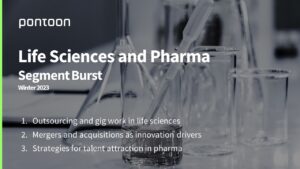Life Sciences and Pharma Segment Burst: Winter 2023
Research
.
In the new volume of Life Sciences and Pharma Segment Burst, we explore the most recent trends in the sector.
Outsourcing and gig work in life sciences
According to PwC’s 2023 report, as pharmaceutical companies delve into the productivity of talent and financial resources measured by function, geography, and product, outscoring is likely to become more prominent. Life sciences leaders will continue to outsource non-core services to third parties that can provide tech-enabled and market-based solutions (including workforce solutions).
Apart from outsourcing non-core services to external providers, life sciences companies are now in the unique position of leveraging gig workers and the growing normalisation of non-traditional working models. Freelancers, independent contractors, and other types of on-demand talent can fill both specialised skills gaps and more general roles based on transferrable skills.
For scientific roles, tapping into academic environments can prove a valuable source of on-demand talent. Scholars are generally used to project-based work as they often secure public funding to make research projects a reality. Their hard work and dedication are rewarded through grants, allowing them to achieve their goals without financial restrictions. However, since winning grant competitions is extremely difficult, young researchers across the globe struggle with the stress of not knowing where their next funding opportunity will come from. These highly-skilled professionals might appreciate working for private life sciences companies where salary is predictable and work-life balance is easier to achieve.
When considering gig working schemes, companies should keep an eye on changing legislation. For instance, in February 2023, the European Parliament voted on a new directive intended to regulate self-employed contractors and gig workers engaged via staffing companies, employers of record, and digital platforms. Even though the directive seems to be mostly geared toward regulating delivery platform workers, the future will show how the new law impacts other types of gig workers in the European Union.
Mergers and acquisitions as innovation drivers
Recent studies show that almost 60% of new drugs are being discovered not by independent pharmaceutical companies but through mergers and acquisitions (M&As) and drug licensing. Research and development productivity in biotechnology and pharmaceuticals is predominantly driven through cross-organisational deals among various entities.
Researchers who studied thirteen pharmaceutical leaders with revenues of over $10 billion USD proved that the rising compound annual growth rate (CAGR) of these companies was clearly correlated with M&A deals. Together with research collaborations, innovation incubators, academic centres of excellence, and public-private partnerships, M&As and drug licensing have grown in importance as methods of innovation over the last decade.
Academia-owned advanced tech spinouts and start-up companies are key players in boosting innovation. Increased financing of these parties, both on governmental and private levels, will prove crucial in positively impacting drug development in the upcoming years.
PwC’s industry report predicts that in 2023 pharmaceutical companies will see a higher volume of transactions, including strategic business partnerships, joint ventures, and alliances – especially for biotech deals within the $5–15 billion range.
The rising importance of M&As will require companies to embrace a new set of strategies and market-leading capabilities – which might also entail a growing need for scientific managers and liaisons as well as legal and compliance talent.
For many of these roles, soft skills and business acumen are equally important as specialised knowledge. Pharmaceutical leaders should take that into consideration and focus on skills when advertising their roles to new generations of workers. With a skills-first approach, industry leaders can develop a holistic view of today’s talent and compare that against the competencies they need to achieve long-term business objectives.
Strategies for talent attraction in pharma
Pharmaceutical Technology’s latest report shows that the previous year has not seen significant pay raises for an overwhelming majority of surveyed pharmaceutical professionals. The percentage of workers reporting an increase in salary dropped from 55% in 2021 to 22% in 2022. For almost three-quarters of employees, remuneration remained approximately the same.
The survey also revealed that the main reported concern was related
to finding proper staff – 35% of those surveyed pointed to an insufficient number of staff with specialised training and almost 23% indicated an insufficient number of staff in general.
These findings suggest that the pharmaceutical industry’s biggest challenge in 2023 will be raising compensation for current workers while attracting new skilled talent to handle the excess workload.
To attract the right talent, companies should incorporate innovation, social impact, and career advancement opportunities into the EVP and job descriptions. A new challenging role combined with competitive pay might be a valuable motivator for a top-quality candidate to switch jobs. After all, top talent is driven by a sense of purpose and the need for constant development.
The importance of systematising role descriptions for talent attraction
Due to the wide array of expertise areas in life sciences, appropriately showcasing roles and skillsets is crucial for creating increased awareness of attractive options available in the industry.
To ensure that candidates can easily identify positions for which they are best suited, companies should systematise job titles and describe required skillsets in terms of both hard and soft skills.
A thorough and systematised approach to job descriptions will be equally appreciated by candidates with previous experience in the field and those who are new to the industry.
Related Post
In the third volume of Life Sciences and Industrial Segment Burst we explore the most recent trends in the sector, including:
How life sciences companies can attract academic talent and ...





